27 Follow-Up Email Subject Line Examples & Tips on How to Write Them

Sending multiple follow-ups can double the response rate of your cold email campaigns. At Hunter, we noticed the campaigns we're doing internally performed 38% better when they included a follow-up email.
We also know from before that subject lines have a significant impact on the success of your emails.
In this guide, we've gathered the most effective follow-up email subject line examples and tips on how to craft them. We also asked industry experts to share their best practices and examples with us.
1. Make a connection with the previous email
When you think about adding follow-ups to your cold email campaigns, there are two key approaches you can take:
- Send the follow-up in the same thread as the initial email
- Send the follow-up as a new message
Each of these methods has its pros and cons. Before jumping into details, let’s have a quick overview of both approaches.
a) Send the follow-up in the same thread as the initial email
At Hunter, we recommend using the same thread with the same subject line for following up on your cold email.
This way, prospects get reminded about the offer from the previous email. Moreover, you can use follow-ups to continue telling the story or offer additional benefits.
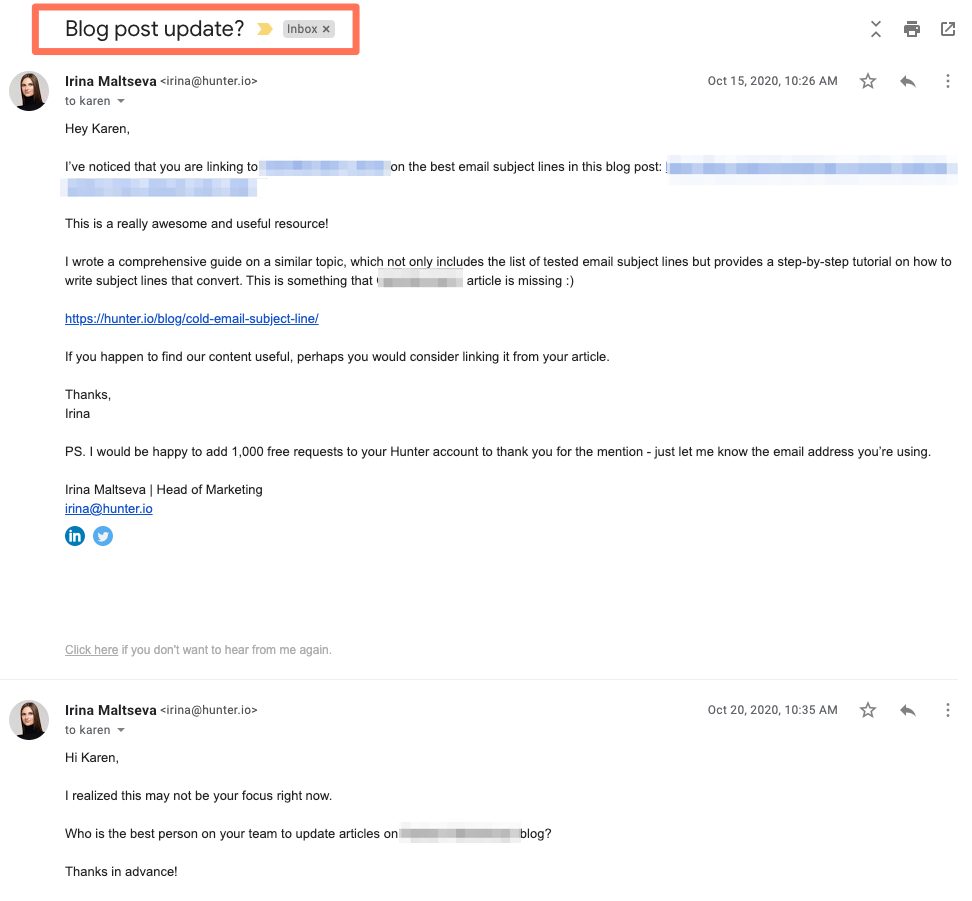
Just imagine sending the same follow-up above as a new email: it would probably be hard for the recipient to remember the context of the first email and who you are.
A follow-up sent from the same thread would be a part of the story you started telling in the first email.
Besides that, changing the subject line to create new threads might be perceived as slightly more aggressive, as they create multiple rows in most popular email clients.
For example, this is how follow-up with a new subject line looks in Gmail:

And here is an example from Outlook:

b) Send the follow-up as a new message
However, there are a few situations where using a new thread to follow up might be relevant.
The typical use cases are:
- Your prospect doesn't open the first email, and you assume that it’s because the subject line wasn’t catchy or relevant.
- You want to test different subject lines for your follow-ups, and you know how to connect all of the previous messages in one story.
- You made a mistake in the initial email and noticed it before sending a follow-up. In this case, you have another opportunity to make the “first impression” once again.
If you want to send a follow-up email in a new thread because of one of these reasons, you need to understand that there's a chance that the recipient will probably not check the original email.
So make sure to provide additional context from your initial email in the follow-up. You should expect the recipient to know enough to start the discussion from the follow-up sent in a new thread.
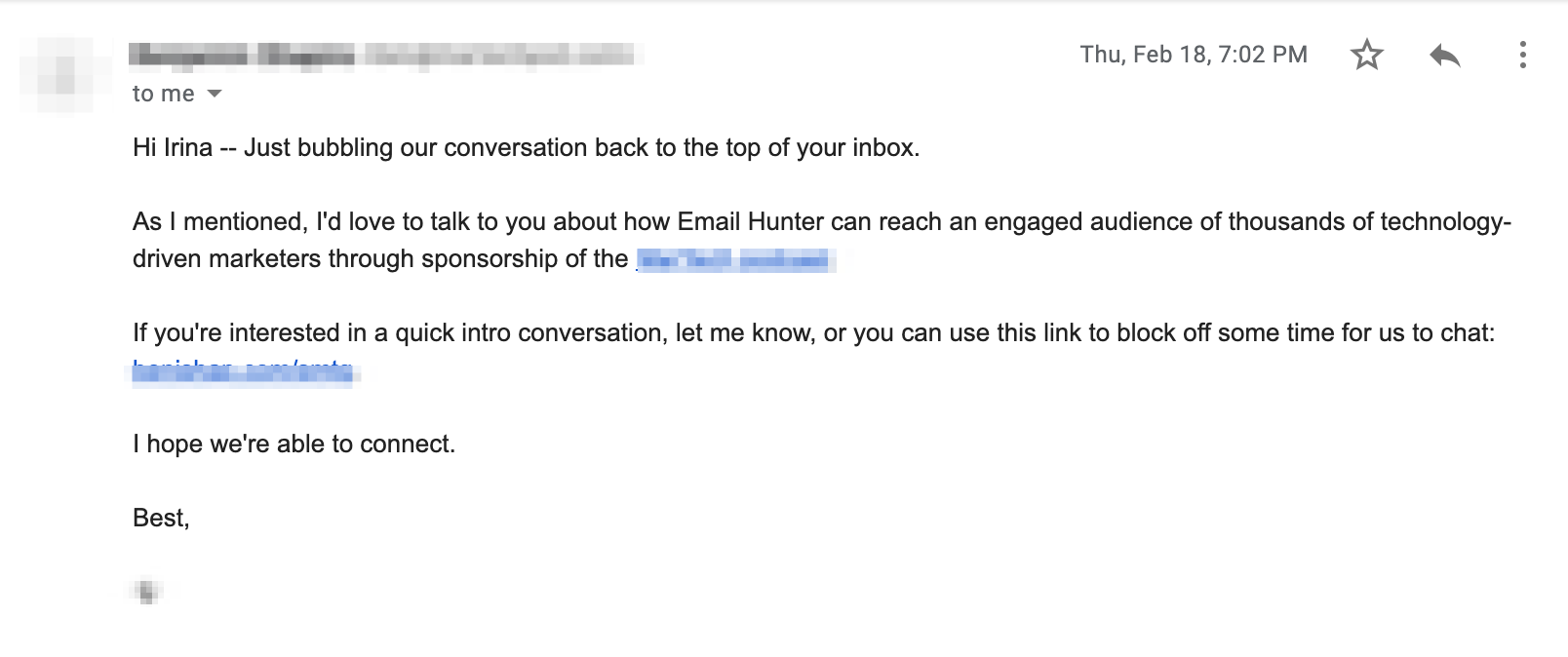
That would be another reason why for most of the cases, we recommend using the same subject line for all your emails—you won't need to explain the reason why you contact your prospect every time in detail.
When you have all of the follow-ups in the same thread, it’s easier to keep them short, catchy, and straight to the point.
However, if you have a good reason to send a follow-up as a new email, you can follow these simple rules to write a compelling subject line that will make prospects open your email.
2. Keep it short and catchy
When trying to write an effective subject line for your follow-up email, try to keep it as short as possible.
It’s much easier to catch a prospect’s attention with something short, sweet, and straight to the point.
Just compare these two subject lines:
- Next steps with {{business}}
- Let’s discuss with you the next steps and how to increase revenue for {{business}}
Which one would you open? Most likely the first one.
People often open emails because of curiosity. Intriguing your prospect with a subject line is something you should consider for your follow-up campaign.
Another reason to keep your follow-up subject lines short is that long subject lines are cut off on mobile devices.

These are some examples of short and catchy follow-up email subject lines:
- Right person
- Moving on
- Ready for {{event}}?
- Check this out, {{first_name}}
- Congrats
3. Make it personal
Personalization is another crucial point for a successful follow-up email subject line. No one loves receiving generic “Hi there/Quick question” emails.
You should do your research before contacting prospects and get as much information on them as possible to make your outreach campaign successful.
To personalize subject lines for your follow-ups, you can start with something as simple as the prospect’s name and company, and go in-depth and add advanced personalization by mentioning their job title, the place you met, the content they wrote, a mutual connection, etc.
Adding a personal touch to your follow-up subject line is your best bet to get high open rates. However, doing this manually can become an issue once you start reaching a large number of prospects.
Fortunately, email outreach tools like Hunter Campaigns can help you save time preparing and scheduling highly-personalized emails. Here's how to do it:
1. Create a CSV file with detailed information about your prospects
Find information about your prospects and gather everything in a single .CSV file.

2. Upload to Hunter Leads
Hunter Leads is a CRM tool that allows you to structure information about your prospects and keep track of the results of your cold outreach.
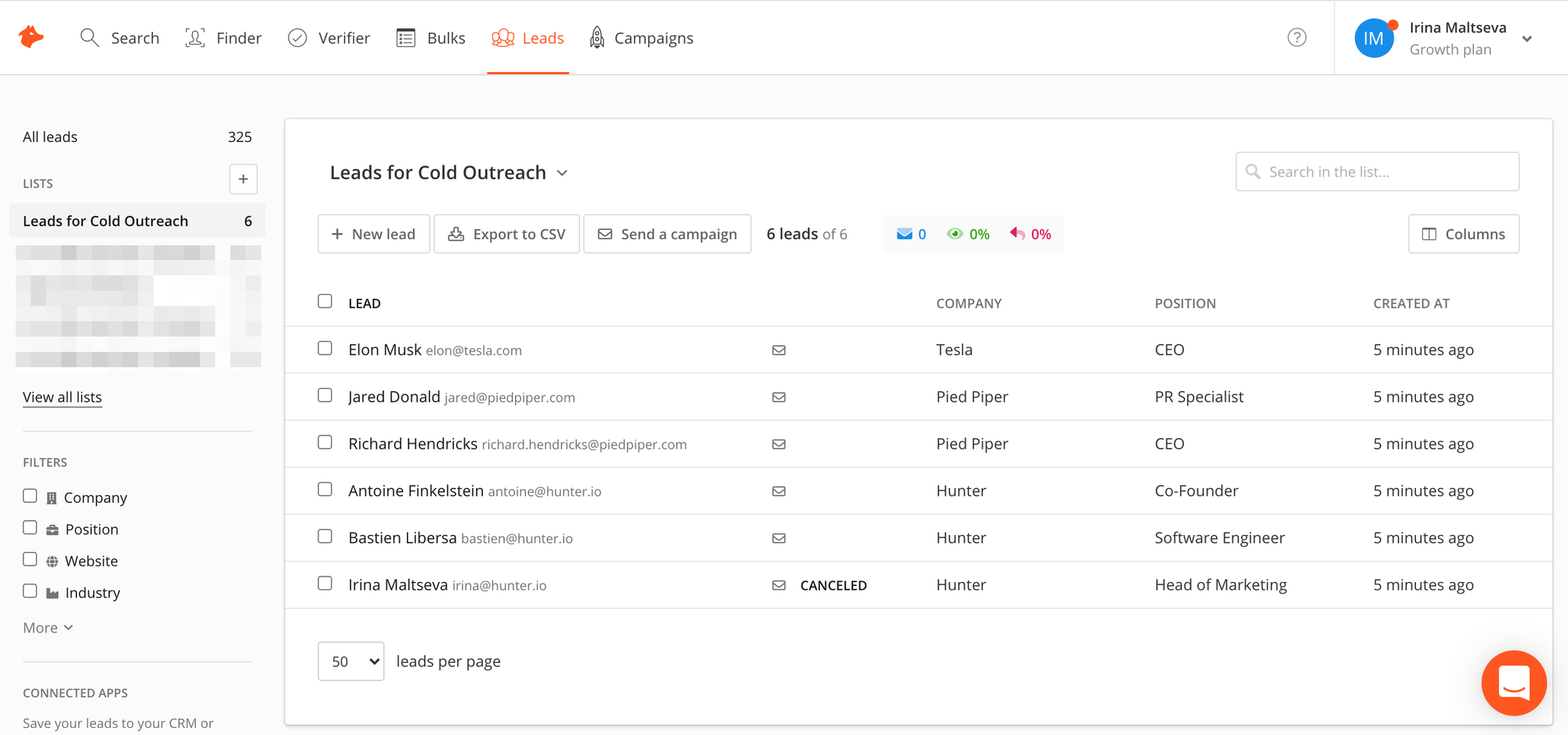
3. Use custom attributes for subject line personalization
Custom attributes allow you to insert personalized snippets about your leads in your subject lines and emails. This is one of the simplest ways to automate your outreach and add a personal touch at the same time.
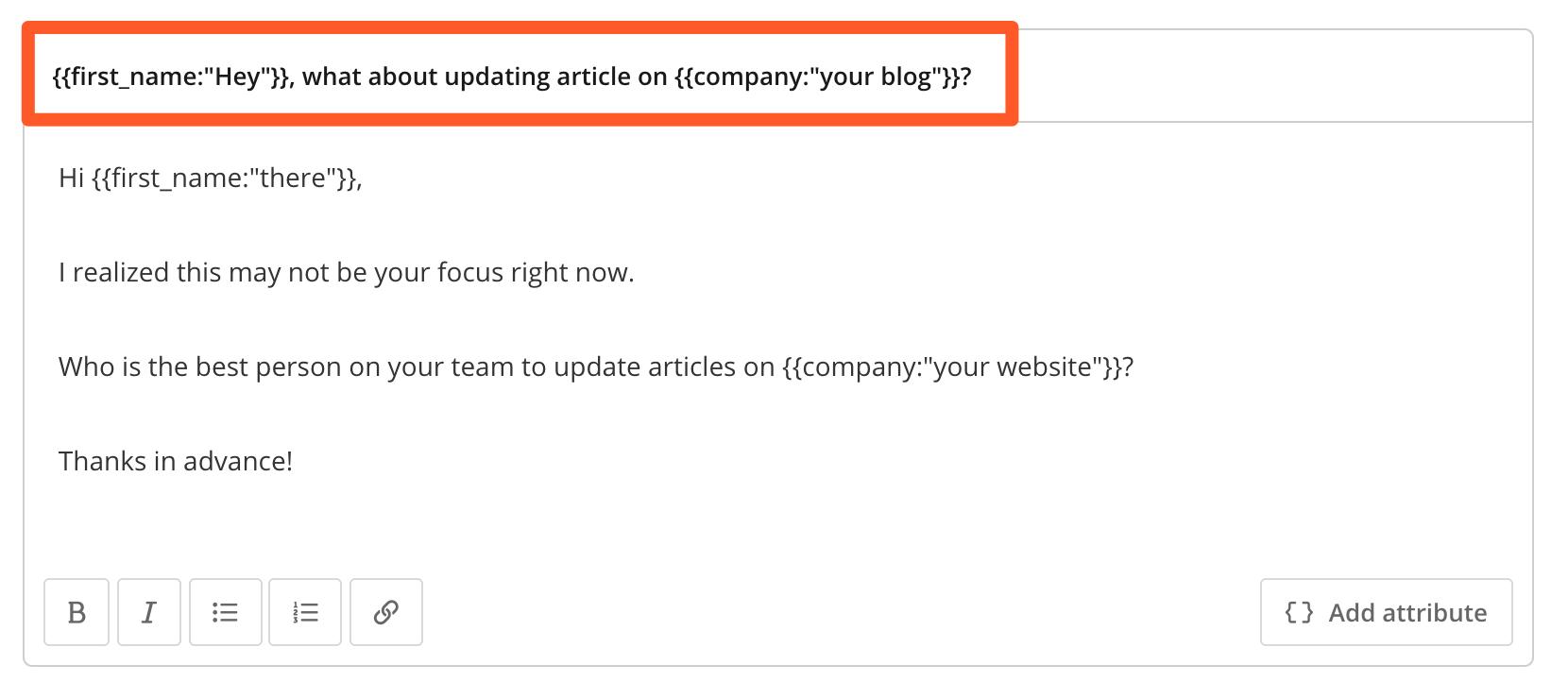
Here are a few examples of personalized subject lines for follow-up emails:
- Your thoughts {{first_name}}?
- I’ve been thinking of {{company}}
- Congrats on {{event}}
- Nice to meet you at {{event}}
4. Ask open-ended questions
Questions are a great way to pique the recipient's curiosity.
Questions also feel incomplete on their own, so they can inspire readers to open your email and search for an answer.
The questions you ask in your follow-up subject line may be ones that the prospect is already asking themselves. It could be related to the problem you shared in the first email, or just something that you think can make your prospect curious.
Try to keep your questions open-ended so your prospect can’t answer them with a “no.”
Here are a few examples:
- What do you need at {{company}}?
- Next steps?
- Have you thought of {{relevant_offer}}?
- Your thoughts?
5. Avoid sounding passive-aggressive
Avoid sounding passive-aggressive or desperate in your follow-up subject lines.
Here's an example that illustrates passive aggression without any further explanation:

Direct aggression is relatively easy to spot, but more subtle passive-aggressive phrases can sneak into your follow-ups almost without thought.
These kinds of microaggressions can exasperate your prospects and quickly chip away at the goodwill and mutual trust you have established.
With your follow-up subject lines, you should show confidence, provide additional value, and interest prospects with your offer, but definitely not come across as aggressive or desperate.
Hence, try to omit such passive-aggressive phrases in the subject lines for your follow-ups:
- I’ve tried to reach you a few times now
- I know you’re busy; I’m busy too
- Any updates on this?
- Friendly reminder
Besides that, try not to use the word “follow-up” in your subject line.
It doesn’t provide any additional value to your prospect besides the information that you’re sending a “reminder” about the previous message that your prospect didn’t find attractive, skipped, or just didn’t have an opportunity to open.
Also, even though you might be upset because your prospect didn’t respond to your previous email, don’t show them your distress. These phrases are a proper signal you sound a bit desperate, so try to omit them as well:
- If it’s not too much trouble
- I apologize in advance for bothering you
- Sorry for being so persistent
6. Automate follow-ups
You can use Hunter Campaigns to automate the whole outreach process, including sending follow-ups.
Once you add your initial email to Campaigns, choose when you want your follow-up to be sent.

You can choose one of the suggested options: from 1 to 14 days, depending on your campaign and goals.
The next step would be to decide whether you want to send all follow-ups in the same thread as the initial email or have each email sent as a new message with a different subject line.
Keep this field empty if you want to send a follow-up as a reply to your previous email:
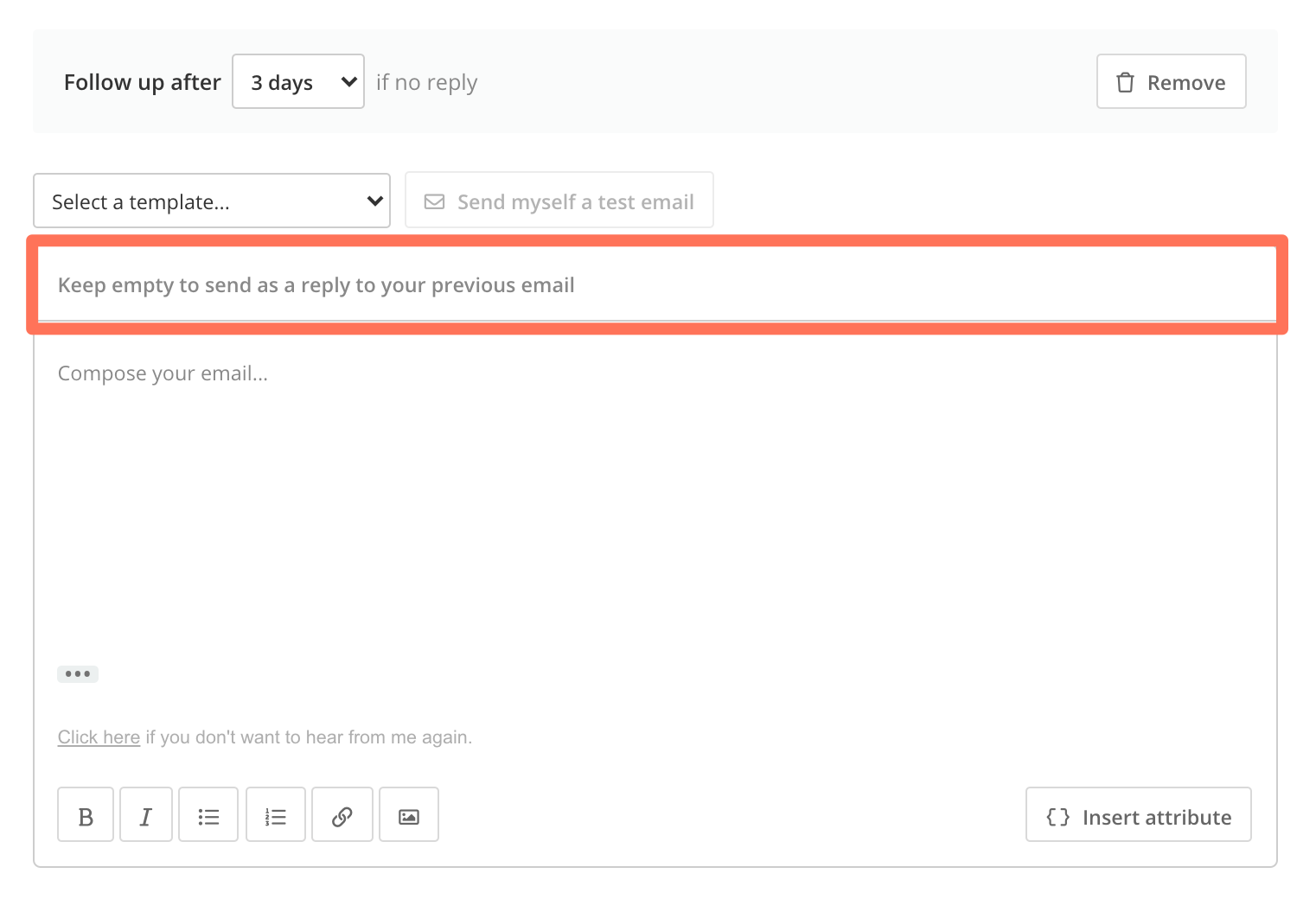
Or add a subject line to send as a new message:

You can add up to three follow-ups to your initial message and customize the delay for each follow-up.
Once your follow-ups are sent, you can track the effectiveness of your follow-ups in the Stats section. You'll be able to see how many follow-ups were sent, opened, clicked, and replied to.
Best follow-up email subject lines tested by industry experts
We contacted a few industry experts and asked them to share their best-performing follow-up subject lines. Here's what they had to say:
{{first_name:"Hey"}} I forgot to mention...
Open Rate: 84.95%"I think that this follow-up subject line has great success because it has the prospect's name in the subject line. It is short and perks people's curiosity to wonder what was not mentioned. It also shows that I'm human and make mistakes, showing a more natural side to myself." – Rachel Steinbauer, Head of Outbound Sales at Kinsta
Yet another candid (but hopeful) attempt at guest posting!
Open Rate: 45.72%"I think this follow-up subject line has always worked well for us because it's short, to the point, and very clearly conveys the email's intention. It also attempts to humbly nudge the reader to open it without trying too hard." – Tanishq Agarwal, Outreach Strategist at Beaconstac
[LIVE WEBINAR] Learn why 70-80% of your visitors aren’t buying
Open Rate: 21.43%"This was a follow-up email we sent after an initial cold outreach email, inviting our mailing list to join a webinar on abandoned cart email practices. The reason this subject line performed well:
1) The focus was e-commerce centric, which we knew most of our subscribers would respond to, as they belong to the same domain, either as marketers, owners or researchers.
2) The subject line incorporated both curiosity ("learn why") and a compelling statistic ("70-80% of your visitors aren't buying") to make the subject line truly eye-catching and worth a click to find out what the email was actually about." – Rukham Khan, Contend Lead at Mailmunch
A quick question {{first_name:"for you"}} ?
Open Rate: 68%"We run link building campaigns on a regular basis, and this follow-up subject line performed the best in the context of gathering new backlink opportunities. In my opinion, it resulted in a high open rate due to the interest of what is behind such a topic. On some level, it has a psychological context as we, humans, are always curious and don’t want to miss that question/offer/deal." - Andriy Zapisotskyi, Growth Manager at Mailtrap
[Reminder] Your Preferences Will Shape The Safe Re-opening Of Hospitality Venues
Open Rate: 35.68%"This follow-up subject line was part of our survey campaign to understand the audience's preferences, inclinations, and hesitations about the future of the hospitality industry in a post-COVID-19 era.
It was a great success as the global event audience resonated with being a contributing factor in the bigger picture. The ownership of contributing and sharing their perspective anonymously made this a success." – Siddharth Das, Content Marketer at Yapsody
❤️ what you do at {{company:"your company"}}
Open Rate: 82%"This follow-up subject line worked because, first, it was personalized. It immediately connected with people and complimented them on their current work. The subject line is short enough to be read in its entirety, even on mobile devices. The subject line also created enough intrigue for people to read what's inside it. We naturally linked the email to their great work at their current role and asked them if they would like to do even greater work here at Recruiterflow." – Ifrah Nasser, Content Marketing Manager at Recruiterflow
Here’s what I’ll do
Open Rate: 61%"Link building emails these days are far too spammy, and they ask for more than they give. People don't care about your blog post. Trust me. They care about the value they will get from you. Using this subject line imputes value, something they will get from opening and reading your email." – Jeremy Moser, Co-Founder & CEO at uSERP
Wrap up
Subject lines are one of the most important parts of your cold outreach. To make someone read your email, you need to make sure they open it first.
By following simple tips from this guide, you’ll be able to significantly increase your chances of getting noticed and increase the open rate for your follow-up emails.
Want to learn more? Check out these guides:
- How to Write a Follow-Up Email After No Response (7 Examples)
- The Best Time to Send an Email (What 9 Studies Say)
- The Complete Guide to Getting Started with Cold Email

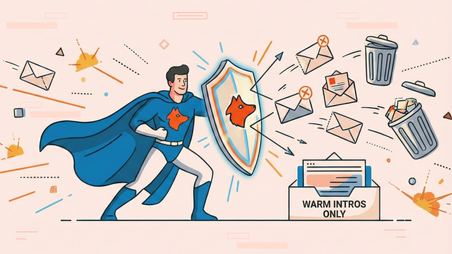


 Send cold emails with Hunter
Send cold emails with Hunter